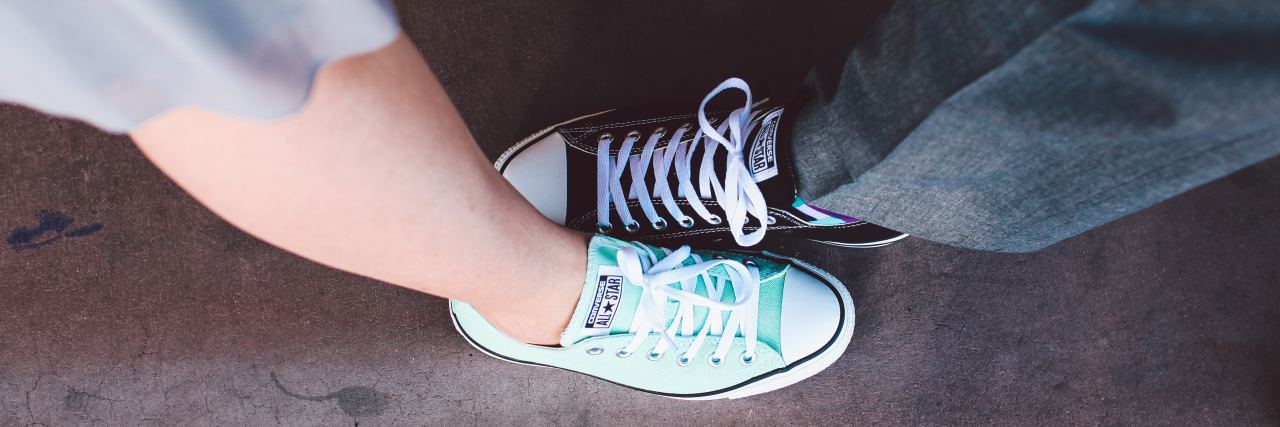People with bipolar disorder often struggle with separating themselves from their disorder. It is a chronic condition people have to manage on a daily basis. Sometimes I struggle with knowing what is the “real me” and what is my illness. By its nature, bipolar disorder affects my moods, emotions, behavior and thoughts. So, it’s difficult to separate this condition from my identity and personality. That’s why I also say “I am bipolar.” This is not a good or bad thing; it’s just a part of who I am.
• What is Bipolar disorder?
I am also genderfluid. For me, this means I experience my gender as a spectrum between masculine and feminine energies – usually lying somewhere in the middle. Typically, I express my gender identity with androgynous fashion and appearance. But this fluctuates depending on a lot of factors, particularly how I’m feeling and my personal connection with my body.
Having bipolar disorder, as well as post-traumatic stress disorder (PTSD), means my connection with my body, my moods, energy levels and behaviors all shift. When I am manic, I am full of energy. I feel alive. I feel electricity running all throughout my body. I want to do all the things. I also tend to feel exceedingly feminine and hypersexual. I tend to wear more feminine clothing, want to show off my female features, and even sometimes want to engage in risky sexual behaviors I usually would not be interested in. When I am manic, I also usually feel more “like a woman,” whatever that means.
When I am depressed, my body image shifts dramatically. I’m not interested in fashion. I don’t feel connected with my body. It’s just a meat suit I wear around, but the real me is what’s inside. I don’t always recognize myself in the mirror or feel like whatever clothes I’m wearing or gender I’m expressing really represent who I am. I dissociate from myself. Sometimes I feel agender, gender neutral or genderless. Sometimes I feel more masculine. I tend to wear baggy clothes, little makeup and don’t care about my personal appearance. I also tend to relate more to men and identify with them.
So, how do I know if my genderfluid identity is “real” or just a symptom of being bipolar? Being both genderfluid and bipolar shapes my identity constantly. The most disconcerting part is the instability of both. I usually like to categorize things – as do all humans – but gender fluidity and bipolar disorder are inherently categorized by their fluctuating characteristics. I know my gender identity is real and not just a symptom of mental illness because it is always present. Sometimes it is more salient than others and sometimes I experience gender dysphoria. When I’m in a stable mood state, my gender identity can shift towards feeling more feminine, more masculine or somewhere in-between. It just depends, but I notice that when I have mood swings these identities and the salience of my gender identity intensifies as well. This makes it easy to question what’s “causing” my gender identity, but I have to remind myself it is real and all of these things are intertwined.
Being bipolar and being genderfluid can be really complicated. I want to believe the way I’m relating to my gender identity is real. I want to believe it’s not just a product of mental illness. It gets so confusing when I feel more feminine and sexualized because I have to check in with myself on whether I’m also starting to feel manic. Sometimes the answer is yes, and sometimes it’s no. When I start feeling more masculine, aggressive, confident and wear men’s clothing, I also have to check in with myself on whether this aggressive energy is part of mania. Usually, the answer is no. And when I start to dissociate from my body, I don’t recognize it; I can’t decide what to wear because nothing feels like “me” and I don’t feel like any particular gender. Again, I need to check in with myself on whether I’m getting depressed or having a mood swing of some kind.
Sometimes it’s impossible to separate my bipolar identity with my gender. This can be frustrating and cause a lot of anxiety because I want to feel like my identities are valid and not something to pathologize. I have to remind myself that like my bipolar mood swings, my gender shifts as well. No matter my mood, my gender still fluctuates. This helps assure me that my gender identity is valid. I have experienced feminine, masculine, and androgynous gender identities while in a stable mood state, as well as while manic or depressed. Still, it’s interesting to question the relationship between the two and how my bipolar disorder can affect which gender I identify with more. I’ll probably never be able to tease apart the cause and effect, but at least it’s helpful to recognize these are separate identities that come together to shape who I am. I am bipolar and I am genderfluid, but my gender identity is not a symptom of my illness.
Author’s note: This is my personal experience as someone who is genderfluid and bipolar. Every genderfluid and gender non-conforming person has their own unique experience and I am not speaking on their behalf.
Photo by Alysa Bajenaru on Unsplash

